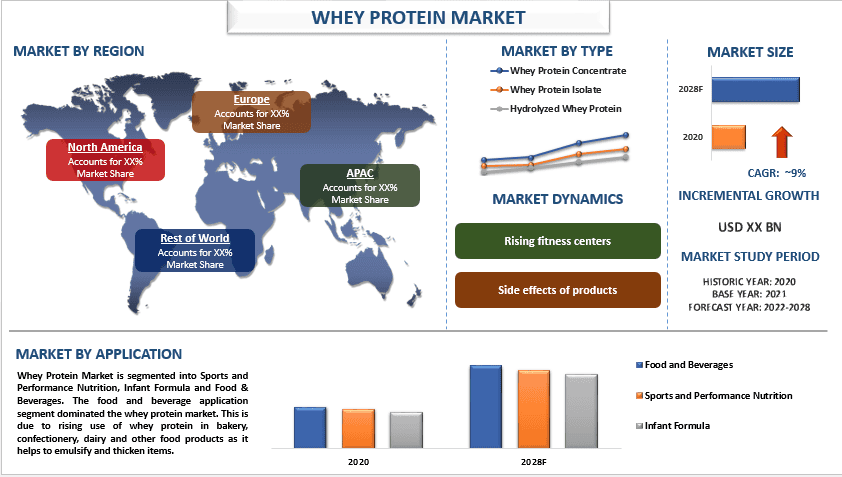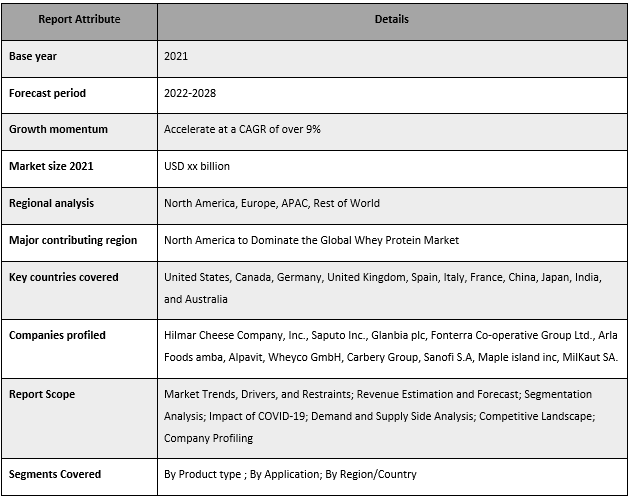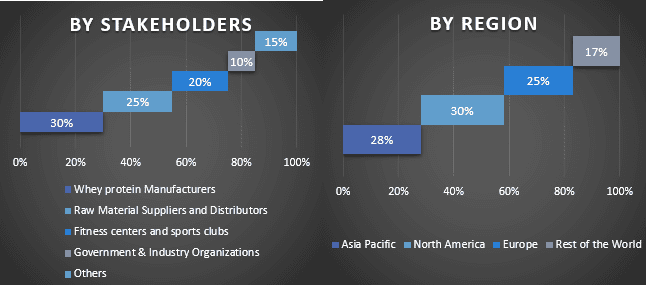- Home
- About Us
- Industry
- Services
- Reading
- Contact Us
Whey Protein Market: Current Analysis and Forecast (2022-2028)
Emphasis on Type (Whey Protein Concentrate, Whey Protein Isolate and Hydrolyzed Whey Protein); and Application (Sports and Performance Nutrition, Infant Formula and Food and Beverages)); and Region/Country

Global Whey Protein Market is expected to grow at a significant rate of around ~9 % during the forecast period. A whey protein is defined as a mixture of proteins isolated from whey, the liquid material created as a by-product of cheese production. Whey protein is basically a good source of protein and contains high nutritional value. To build lean muscle mass and help with muscle protein synthesis, bodybuilders and weight trainers frequently use whey protein as a supplement to their diets. In recent years, the demand for whey protein has risen dramatically due to the rising awareness and interest of healthy lifestyles. Furthermore, the rise in the recommendation of disposable whey protein by fitness club and sports club has boosted market growth. In addition, major players in the market are working towards launching whey protein.
Hilmar Cheese Company, Inc., Saputo Inc., Glanbia plc, Fonterra Co-operative Group Ltd., Arla Foods amba, Alpavit, Wheyco GmbH, Carbery Group are some of the key players in the market. Several M&As along with partnerships have been undertaken by these players to facilitate customers with hi-tech and innovative products/technologies.
Insights Presented in the Report
“Amongst type, whey protein concentrate (WPC) category to witness higher CAGR during the forecast period”
Based on type, the market is segmented into whey protein concentrate (WPC), whey protein isolate (WPI) and whey protein hydrolysate (WPH). Whey protein concentrate (WPC) market category is to witness higher CAGR during the forecast period owing to the consumer preferences for incorporating proteins in regular foods, as well as rising demand for high-protein and low-fat weight management products. WPC is basically a part of whey proteins that are soluble in whey, and they contain lactose, lipids, and minerals which are very useful for the daily diet. It is further used for the production of beverages and dairy products. In 2021, Whey Protein Isolate (WPI) segment held a significant share of the global revenue.
“Amongst Application type, the Food and beverages to hold a significant share in the market in 2021”
On the basis of application type, the Whey Protein Market is segmented into sports and performance nutrition, infant formula and food & beverages. The food and beverage application segment dominated the whey protein market and represented over largest portion of the worldwide income in 2021. The product is also preferred for bakery and confectionary products because of its capacity to emulsify and thicken items. For instance, Glanbia Nutritionals boosted its protein capabilities in 2018 by bringing BevEdge Whey Protein A-220W, which is a pre-acidified whey protein isolate that enables the creation of berry citrus-flavored protein drink mixes.

“North America to hold a significant share in the market”
In 2021, North America led the global industry and accounted for the maximum share of the global revenues. This is due to the increasing awareness of healthy lifestyles and high disposable income levels among the people. Hence, supports the region’s growth. Furthermore, these supplements also offer various health benefits in addition to basic nutrition, especially in the form of infant formula. All these factors have led to a boost in demand for whey protein in the region.
Reasons to buy this report:
- The study includes market sizing and forecasting analysis validated by authenticated key industry experts.
- The report presents a quick review of overall industry performance at one glance.
- The report covers an in-depth analysis of prominent industry peers with a primary focus on key business financials, product portfolio, expansion strategies, and recent developments.
- Detailed examination of drivers, restraints, key trends, and opportunities prevailing in the industry.
- The study comprehensively covers the market across different segments.
- Deep dive regional level analysis of the industry.
Customization Options:
The global whey protein market can further be customized as per the requirement or any other market segment. Besides this, UMI understands that you may have your own business needs, hence feel free to connect with us to get a report that completely suits your requirements.
Table of Content
Research Methodology for the Whey Protein Market Analysis (2022-2028)
Analyzing the historical market, estimating the current market, and forecasting the future market of the global whey protein market were the three major steps undertaken to create and analyze the adoption of the whey protein market in major regions globally. Exhaustive secondary research was conducted to collect the historical market numbers and estimate the current market size. Secondly, to validate these insights, numerous findings and assumptions were taken into consideration. Moreover, exhaustive primary interviews were also conducted, with industry experts across the value chain of the global whey protein market. Post assumption and validation of market numbers through primary interviews, we employed a top-down/bottom-up approach to forecasting the complete market size. Thereafter, market breakdown and data triangulation methods were adopted to estimate and analyze the market size of segments and sub-segments of the industry pertains to. Detailed methodology is explained below:
Analysis of Historical Market Size
Step 1: In-Depth Study of Secondary Sources:
Detail secondary study was conducted to obtain the historical market size of the whey protein market through company internal sources such as annual reports & financial statements, performance presentations, press releases, etc., and external sources including journals, news & articles, government publications, competitor publications, sector reports, third-party database, and other credible publications.
Step 2: Market Segmentation:
After obtaining the historical market size of the whey protein market, we conducted a detailed secondary analysis to gather historical market insights and share for different segments & sub-segments for major regions. Major segments are included in the report as product type and application. Further country-level analyses were conducted to evaluate the overall adoption of testing models in that region.
Step 3: Factor Analysis:
After acquiring the historical market size of different segments and sub-segments, we conducted a detailed factor analysis to estimate the current market size of the whey protein market. Further, we conducted factor analysis using dependent and independent variables such as the growing prevalence of health nutrition, etc. A thorough analysis was conducted for demand and supply-side scenarios considering top partnerships, mergers and acquisitions, business expansion, and product launches in the whey protein market sector across the globe.
Current Market Size Estimate & Forecast
Current Market Sizing: Based on actionable insights from the above 3 steps, we arrived at the current market size, key players in the global whey protein market, and market shares of the segments. All the required percentage shares split, and market breakdowns were determined using the above-mentioned secondary approach and were verified through primary interviews.
Estimation & Forecasting: For market estimation and forecast, weights were assigned to different factors including drivers & trends, restraints, and opportunities available for the stakeholders. After analyzing these factors, relevant forecasting techniques i.e., the top-down/bottom-up approach were applied to arrive at the market forecast for 2028 for different segments and sub-segments across the major markets globally. The research methodology adopted to estimate the market size encompasses:
- The industry’s market size, in terms of revenue (USD) and the adoption rate of the whey protein market across the major markets domestically
- All percentage shares, splits, and breakdowns of market segments and sub-segments
- Key players in the global whey protein market in terms of products offered. Also, the growth strategies adopted by these players to compete in the fast-growing market
Market Size and Share Validation
Primary Research: In-depth interviews were conducted with the Key Opinion Leaders (KOLs) including Top Level Executives (CXO/VPs, Sales Head, Marketing Head, Operational Head, Regional Head, Country Head, etc.) across major regions. Primary research findings were then summarized, and statistical analysis was performed to prove the stated hypothesis. Inputs from primary research were consolidated with secondary findings, hence turning information into actionable insights.
Split of Primary Participants in Different Regions

Market Engineering
The data triangulation technique was employed to complete the overall market estimation and to arrive at precise statistical numbers for each segment and sub-segment of the global whey protein market. Data was split into several segments & sub-segments post studying various parameters and trends in the areas of product type and application in the global whey protein market.
The main objective of the Global Whey Protein Market Study
The current & future market trends of the global whey protein market were pinpointed in the study. Investors can gain strategic insights to base their discretion for investments on the qualitative and quantitative analysis performed in the study. Current and future market trends determined the overall attractiveness of the market at a regional level, providing a platform for the industrial participant to exploit the untapped market to benefit from a first-mover advantage. Other quantitative goals of the studies include:
- Analyze the current and forecast market size of the whey protein market in terms of value (USD). Also, analyze the current and forecast market size of different segments and sub-segments
- Segments in the study include areas of product type and application.
- Define and analysis of the regulatory framework for the whey protein industry.
- Analyze the value chain involved with the presence of various intermediaries, along with analyzing customer and competitor behaviors of the industry.
- Analyze the current and forecast market size of the whey protein market for the major region.
- Major countries of regions studied in the report include Asia Pacific, Europe, North America, and the Rest of the World.
- Company profiles of the whey protein market and the growth strategies adopted by the market players to sustain in the fast-growing market
- Deep dive regional level analysis of the industry
Related Reports
Customers who bought this item also bought










